The History of Châteauneuf-de-Randon |
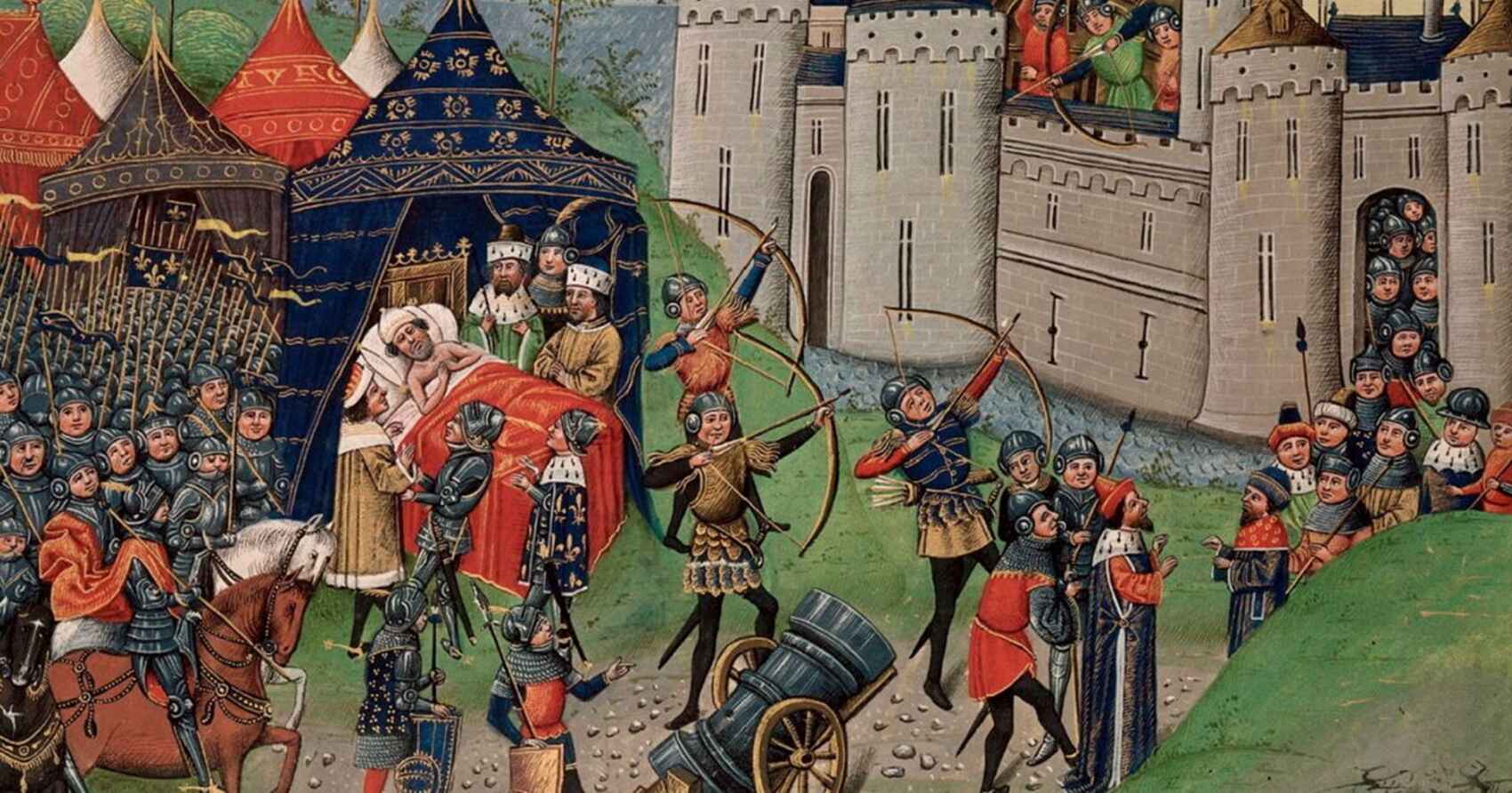
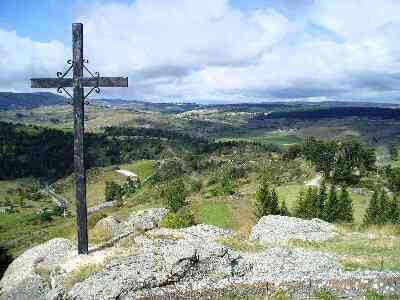 A very long time ago, a castle had apparently been built at the top of the mountain where Châteauneuf later rose. However, we are completely ignorant of the periods during which these fortresses were built. We know no more about the beginnings of the town of Randon. It owed its high importance to the strong position of the castle, which elevated it to the rank of the main baronies in the country. There exists a charter from Raymond-Bérenger, Count of Barcelona, granted of his own accord, and part of Gévaudan through his wife Douce, dated April 1126: this document grants in fief the castle of Randon Castrum quod vocatur Rando to the brothers Guarin and Odilon and to their descendants in perpetuity.
A very long time ago, a castle had apparently been built at the top of the mountain where Châteauneuf later rose. However, we are completely ignorant of the periods during which these fortresses were built. We know no more about the beginnings of the town of Randon. It owed its high importance to the strong position of the castle, which elevated it to the rank of the main baronies in the country. There exists a charter from Raymond-Bérenger, Count of Barcelona, granted of his own accord, and part of Gévaudan through his wife Douce, dated April 1126: this document grants in fief the castle of Randon Castrum quod vocatur Rando to the brothers Guarin and Odilon and to their descendants in perpetuity.
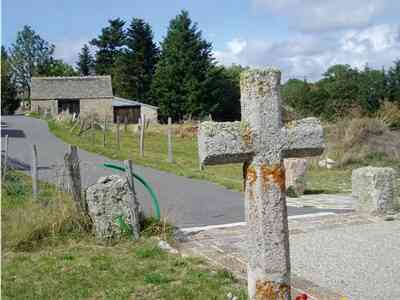 In the middle of the same century, Guillaume de Randon, probably their successor, was, along with other lords of the land, a witness to the cession made by Pagane of all his goods to his brother Bernard-Atton, Count of Nîmes (1152). Under the episcopate of Guillaume de Peire from 1187 to 1223, the lords of Randon founded or richly endowed the monastery of Mercoire, in a forest in the mountains of Gévaudan, near the sources of the Allier.
In the middle of the same century, Guillaume de Randon, probably their successor, was, along with other lords of the land, a witness to the cession made by Pagane of all his goods to his brother Bernard-Atton, Count of Nîmes (1152). Under the episcopate of Guillaume de Peire from 1187 to 1223, the lords of Randon founded or richly endowed the monastery of Mercoire, in a forest in the mountains of Gévaudan, near the sources of the Allier.
This abbey, the only one of the diocese (Mende, received daughters from the Cistercian order). Bishop Guillaume de Peiire had violent disputes with Randon of Châteauneuf, whom he accused of committing acts of violence against the peasants, his vassals. The other lords of the region were hardly more humane: the prelate wanted to set an example; he invaded the domains of Randon of Châteauneuf, took eighteen of his castles, and forced him to seek peace.
The town of Châteauneuf-de-Randon had as its lord, around 1226, Odilon Guarin, according to a monument of the time; he held his barony in fief from the church of Mende or from the abbey of Saint-Gilles: informed of the invasion plans of King Louis VIII of France, the baron of Randon wrote to protest his willingness to recognize him as his sovereign and to receive royal troops in his strongholds should they take the road to Gévaudan.
From 1233 to 1243, the lords of Châteauneuf-de-Randon and Tournel fought against Pons V, Viscount of Polignac, concerning the barony of Ceissac, of which they disputed half as heirs of Guillemette de Polignac; Bernard de Montaigu, Bishop of Puy, restored peace between the opposing parties. This is the first time there is mention of an alliance between the Randons and the house of Polignac, in which they would soon completely merge. Guillaume, lord of Randon, married, before the end of the century, Walburge, the eldest daughter of Hugues, Count of Rodez, and Ysabeau de Roquefeuil. His only daughter was married to Armand IV, Viscount of Polignac, who died in 1289; from this union were born two sons, Armand V, Viscount of Polignac, and Guillaume, ancestor of the new branch of the lords of Randon.
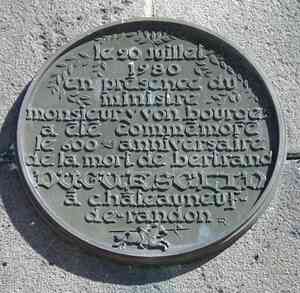 The political prominence of the lords of Randon was so well recognized that on the occasion of the disputes of Philippe le Bel with Pope Boniface VIII, the act of appeal from the seneschal of Beaucaire was drawn up in the name of Guillaume de Randon (1303). It seems that this lord had acquired the barony of Portes, since in 1321, he sold it to Raymond-Guillaume de Budes. Châteauneuf was one of the fortified places in Gévaudan that the companies seized around 1361: it fell into the hands of one of their leaders, S Éguin de Badefol, a Gascon knight, who roamed the country at the head of three thousand looters. In the absence of the constable of Fiennes, lieutenant of the king in Languedoc, Garin, lord of Apchier, his general captain in Gévaudan and Velay, levied a tax on the inhabitants of these two regions, both to maintain a body of troops and to redeem the fortresses of Châteauneuf and Baude from the hands of the leader of the routiers.
The political prominence of the lords of Randon was so well recognized that on the occasion of the disputes of Philippe le Bel with Pope Boniface VIII, the act of appeal from the seneschal of Beaucaire was drawn up in the name of Guillaume de Randon (1303). It seems that this lord had acquired the barony of Portes, since in 1321, he sold it to Raymond-Guillaume de Budes. Châteauneuf was one of the fortified places in Gévaudan that the companies seized around 1361: it fell into the hands of one of their leaders, S Éguin de Badefol, a Gascon knight, who roamed the country at the head of three thousand looters. In the absence of the constable of Fiennes, lieutenant of the king in Languedoc, Garin, lord of Apchier, his general captain in Gévaudan and Velay, levied a tax on the inhabitants of these two regions, both to maintain a body of troops and to redeem the fortresses of Châteauneuf and Baude from the hands of the leader of the routiers.
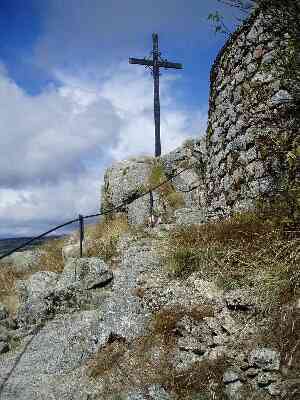 In 1362, Marshal d'Audeneham, general captain of Languedoc, yielding to the demands of the Estates, went in person to lay siege to Salgues, one of the main hideouts of these companies. He was valiantly assisted in this venture by Armand VI, Viscount of Polignac. This lord had initially borne the name Randonnet; he was the son of Guillaume de Randon, who died in Paris, on his return from the wars in Flanders; Armand V having made him his heir, he united the barony of Randon and the viscountcy of Polignac in his hands.
In 1362, Marshal d'Audeneham, general captain of Languedoc, yielding to the demands of the Estates, went in person to lay siege to Salgues, one of the main hideouts of these companies. He was valiantly assisted in this venture by Armand VI, Viscount of Polignac. This lord had initially borne the name Randonnet; he was the son of Guillaume de Randon, who died in Paris, on his return from the wars in Flanders; Armand V having made him his heir, he united the barony of Randon and the viscountcy of Polignac in his hands.
Armand VI had disputed, sword in hand, the succession of the domains of the house of Polignac with Arnaud, lord of La Rouë; and on both sides, great excesses had been committed (1357). The Marshal d'Audeneham, to acknowledge his services during the siege of Salgues, granted him letters of remission on March 23, 1362; it is stated that Armand had followed this campaign with five hundred men-at-arms, both on foot and on horseback. The historian of the house of Polignac even claims that the contingent of the lord of Randon did not amount to less than one hundred twenty men-at-arms and one thousand infantry, his vassals, all paid at his expense.
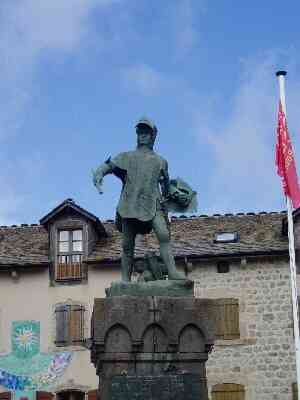 We have now arrived at a famous era, not only in the annals of Gévaudan but in the history of France. The life of an illustrious captain who had filled the world with his name came to an end, like a meteor, at the foot of the walls of Châteauneuf-de-Randon at the end of the 14th century. This land then received the religious consecration that some privileged parts of the earth get from the birth or death of great men.
We have now arrived at a famous era, not only in the annals of Gévaudan but in the history of France. The life of an illustrious captain who had filled the world with his name came to an end, like a meteor, at the foot of the walls of Châteauneuf-de-Randon at the end of the 14th century. This land then received the religious consecration that some privileged parts of the earth get from the birth or death of great men.
In 1380, several companies, half English and half Gascon, favored by incursions from the troops of King Edward III of England, had taken up quarters in the castles on the borders of Languedoc, Auvergne, and Limousin. Among other strongholds, they occupied Châteauneuf-de-Randon. The communes of Languedoc sent deputies to King Charles V of France to ask him to send them an experienced captain, offering, moreover, to cover the costs of the war through a tax of three gold francs per household and twelve deniers per pound of merchandise, in addition to the collection of a double gabelle.
The king ordered Bertrand Du Guesclin to take command of the province. The constable opened the campaign in Auvergne in the first days of July 1380, with the capture of the castle of Challier, to which the Duke of Berry attended. Next, entering Languedoc through the Gèvaudan passes, he laid siege to Châteauneuf-de-Randon. Du Guesclin was surrounded by a brilliant retinue of knights. Among them was Marshal Louis de Sancerre, Alain de Beaumont, Sir Olivier de Mauny, and several other renowned captains, but Du Guesclin's brother-in-arms, Olivier de Clisson, did not follow him into Languedoc, as the historian Villaret wrongly asserts, based on an old chronicle. Some lords from Auvergne and Velay sent their vassals to bolster the Constable's troops. This great castle-taker could therefore believe that he would not be stopped long in front of the fortress of Châteauneuf-de-Randon.
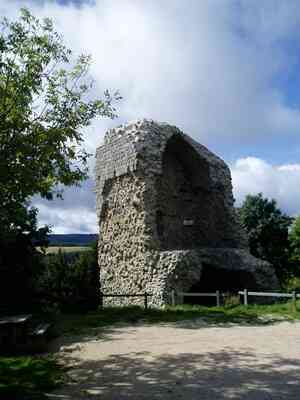 But he was nearing the end of his glorious career, and it seemed that the whole army had been gathered just to witness his end and honor his last moments. Du Guesclin was indeed going to die among those men-at-arms whom he had fathered, and whom he had so often led to victory, and even more frequently nourished or paid at his own expense with patriotic generosity, as if he had acquired his immense personal fortune only to spend it in the service of the state. He was pressuring the siege of Châteauneuf-de-Randon. The governor of the place, whose garrison was numerous and well supplied with provisions and artillery, had refused to surrender.
But he was nearing the end of his glorious career, and it seemed that the whole army had been gathered just to witness his end and honor his last moments. Du Guesclin was indeed going to die among those men-at-arms whom he had fathered, and whom he had so often led to victory, and even more frequently nourished or paid at his own expense with patriotic generosity, as if he had acquired his immense personal fortune only to spend it in the service of the state. He was pressuring the siege of Châteauneuf-de-Randon. The governor of the place, whose garrison was numerous and well supplied with provisions and artillery, had refused to surrender.
The call for an assault rang out in the French camp, and the soldiers rushed toward the castle, which was fiercely assaulted; but the English captain, at the head of his men, waited for the attackers and repelled them several times. Du Guesclin was irritated by this resistance. He swore that "he would never leave until he had the castle at his pleasure": and the Marshal of Sancerre signified in his name to the English governor that he and his men would be put to the sword if the place was taken by storm. The Englishman requested a truce of twenty-four hours and came to the camp of the besiegers. He committed to hand over the keys of Châteauneuf-de-Randon to the constable on a certain day, if in the meantime, no help came to him. As a pledge of his promise, he gave hostages.
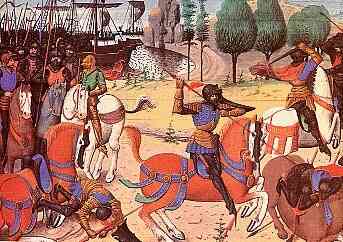 It was after imposing this capitulation on the besieged that Du Guesclin fell ill, according to an ancient chronicler. For some time he had undoubtedly been feeling the effects and secret weaknesses of the illness to which he would soon succumb; and whether he foresaw his impending end or wished to put his affairs in order, he made his will on July 9, adding a codicil the following day. We have this document before us.
It was after imposing this capitulation on the besieged that Du Guesclin fell ill, according to an ancient chronicler. For some time he had undoubtedly been feeling the effects and secret weaknesses of the illness to which he would soon succumb; and whether he foresaw his impending end or wished to put his affairs in order, he made his will on July 9, adding a codicil the following day. We have this document before us.
"In the name of the blessed Trinity, the Father, the Son, and the Holy Spirit," it says, "we, Bertrand Du Guesclin, Count of Longueville, healthy in our mind, despite being physically infirm, knowing that nothing is more certain than death, and nothing more uncertain than the hour of it, wishing to remain intestate, do make and ordain our will in the form and manner that follows, etc." His testamentary provisions are, moreover, few in number. They relate to the legacies he makes to the churches for the repose of his soul; to the place of his burial that he chooses to be "in the church of the Jacobins of Dinan, in the chapel of his predecessors"; to the settlement of his debts; and to some legacies, the main one assuring Bertrand Du Guesclin, son of his cousin Olivier, an annual pension of one hundred livres.
This last provision is confirmed and amplified by the codicil. The constable designates Sir Olivier de Mauny, Sir Hervé de Mauny, and Jean Le Bouteiller as his executors. The last lines of the will inform us that Du Guesclin was not camped under a tent, in the midst of his men, as one might believe based on the erroneous accounts of some historians: "This was done," it states, "in the house of our residence, during the siege before Châteauneuf-de-Randon, in the seneschalty of Beaucaire, in the year and on the day above mentioned."
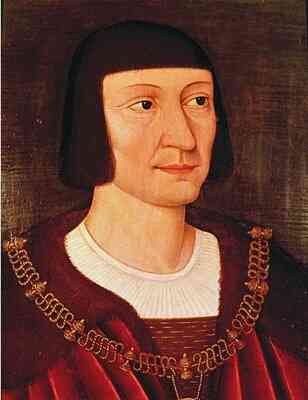 The illness progressed so rapidly that, four days later, the constable found himself at death's door. The distress was deep in the French army: knights and soldiers were shedding tears. "O honor and chivalry," shouted some, "so much will be lost when this one dies!" — "Alas!" cried others, "now we lose our good father and captain, our good shepherd, who so gently nourished us and securely led us; and if we have any good and honor, it is thanks to him!" All around, one could hear nothing but lamentations and groans. The agitation was so great in the French camp that the besieged noticed it from the top of the castle walls, yet could not make sense of it.
The illness progressed so rapidly that, four days later, the constable found himself at death's door. The distress was deep in the French army: knights and soldiers were shedding tears. "O honor and chivalry," shouted some, "so much will be lost when this one dies!" — "Alas!" cried others, "now we lose our good father and captain, our good shepherd, who so gently nourished us and securely led us; and if we have any good and honor, it is thanks to him!" All around, one could hear nothing but lamentations and groans. The agitation was so great in the French camp that the besieged noticed it from the top of the castle walls, yet could not make sense of it.
Called to the bedside of the constable were the Marshal of Sancerre, whom he held as "a very good knight," Sir de Mauny, and "the chivalry of the siege" to receive his last farewells. "Lords," he said to them, "of your company, I must shortly depart for death, which comes to all. It is by your valor, and not by me, that fortune and great honor throughout France have held in my lifetime, and to you is all the honor, which my soul commends to you. Surely, Lords, I had intended to quickly conclude the wars of France by your valor and to return the entire kingdom to King Charles in obedience; but I cannot remain with you any longer. And yet I ask God, my Creator, to give you courage always towards the King, that through you, Sir Marshal, and by your valor and that of all the knighthood who have always esteemed him so valiantly and loyally, his wars may be concluded."
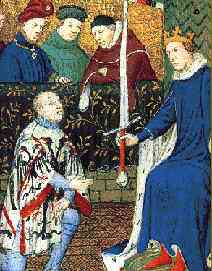 Then, he entrusted his brave companions in arms, his soul, his wife, and all his "kin." Then, having his constable's sword brought to him, he turned toward the Marshal of Sancerre and addressed him again with these words: "To King Charles of France, my sovereign lord, you will recommend me and this sword, under whose governance France is, I commend to you; for into the hands of none more loyal can I put it to guard." He barely had the strength to finish, raised his hand to make the sign of the cross, and peacefully surrendered his soul to God (July 13, 1380).
Then, he entrusted his brave companions in arms, his soul, his wife, and all his "kin." Then, having his constable's sword brought to him, he turned toward the Marshal of Sancerre and addressed him again with these words: "To King Charles of France, my sovereign lord, you will recommend me and this sword, under whose governance France is, I commend to you; for into the hands of none more loyal can I put it to guard." He barely had the strength to finish, raised his hand to make the sign of the cross, and peacefully surrendered his soul to God (July 13, 1380).
The constable had expressed to the Marshal of Sancerre the desire that the surrender of Châteauneuf-de-Randon take place before his death. The Marshal summoned the English governor to fulfill his commitments, taking care, however, to conceal Du Guesclin's illness from him. The Englishman, according to a well-credentialed account, requested to see the constable, as if he had some suspicion; but he was told that he refused any communication with the garrison of the castle. Pressed by the Marshal, the English captain finally consented to surrender. When he was brought before Du Guesclin to present the keys of Châteauneuf-de-Randon, he was astonished to find him dying. According to another version, which its very implausibility has led most historians to adopt, the English governor, although informed of the French hero's death, nonetheless came to honorably place the keys of the place on his coffin.
Historian Villaret adds that all this scene took place in the constable's tent, where he has the enemy commander march in with his garrison. For our part, we tend to trust the supplement of the old Chronicle of Du Guesclin, which presents the events in a very different light and in a more plausible manner. The English captain, as it suited a leader of routiers, did not take offense. Informed of Du Guesclin's death, he would have disregarded the Marshal of Sancerre's summons; he would have responded as one released from his promises. In short, the Marshal would not have succeeded in lowering the drawbridge of the castle before the banner of the constable without threatening to take revenge, by the immediate execution of the hostages, and in the sight of the besieged, for the bad faith of their leader.
What seems accepted by history is that Du Guesclin lived long enough to be a witness to this final advantage of his arms. After his death, the Marshal of Sancerre led the royal army to the siege of Montferrand: he took care, before departing, to leave a troop of soldiers and crossbowmen garrisoned at Châteauneuf-de-Randon.
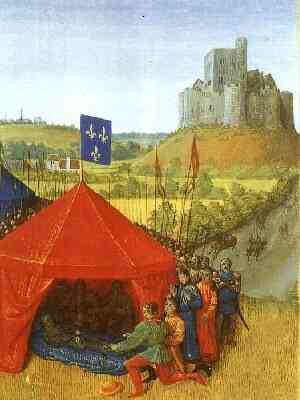 The body of the constable was embalmed, and under the guidance of Olivier de Mauny and Alain de Beaumont, it was initially transported to Puy-en-Velay. There, it lay exposed for one day in the church of the Jacobins of that city, where the inhabitants held a solemn service on July 23 in honor of the illustrious dead. From there, the funeral procession set off to cross France, receiving everywhere on its way the most prominent marks of respect and mourning from the grieving populations. The clergy, the monastic orders, and the bourgeoisie went in procession to meet these "glorious remains"; then, after surrounding them with some religious homage in the main church of the city, they escorted them outside the walls by torchlight.
The body of the constable was embalmed, and under the guidance of Olivier de Mauny and Alain de Beaumont, it was initially transported to Puy-en-Velay. There, it lay exposed for one day in the church of the Jacobins of that city, where the inhabitants held a solemn service on July 23 in honor of the illustrious dead. From there, the funeral procession set off to cross France, receiving everywhere on its way the most prominent marks of respect and mourning from the grieving populations. The clergy, the monastic orders, and the bourgeoisie went in procession to meet these "glorious remains"; then, after surrounding them with some religious homage in the main church of the city, they escorted them outside the walls by torchlight.
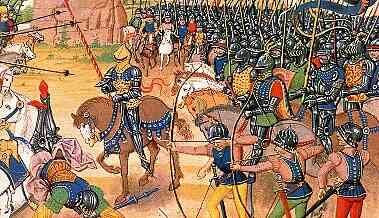 Even in the presence of these almost royal funerals, people struggled to accept the idea that Bertrand Du Guesclin had ceased to live. There is such a glow of immortality in these great natures that one can hardly believe they are, like others, subject to death. The funeral procession, before it could reach Brittany, was, as is known, forced to turn back on the order of Charles V: the king had the mortal remains of the constable laid to rest in the vaults of Saint-Denis, at the foot of the tomb he had erected for himself, where he himself would be buried around mid-September of the same year.
Even in the presence of these almost royal funerals, people struggled to accept the idea that Bertrand Du Guesclin had ceased to live. There is such a glow of immortality in these great natures that one can hardly believe they are, like others, subject to death. The funeral procession, before it could reach Brittany, was, as is known, forced to turn back on the order of Charles V: the king had the mortal remains of the constable laid to rest in the vaults of Saint-Denis, at the foot of the tomb he had erected for himself, where he himself would be buried around mid-September of the same year.
The church of the Jacobins in Puy kept Du Guesclin's entrails: that of the Dominicans in Dinan had his heart. It would be difficult for us to specify the age at which this hero died: the learned authors of the History of Languedoc say that he was sixty-six; this settles the question of his birth and relates it to the year 1320. Although we have also settled on that date in our account of the city of Rennes, we acknowledge that it is not generally accepted. Among Du Guesclin's biographers, some say he was born in 1311, others in 1314, and some even in 1324; so that between the two extremes, there is a difference of thirteen years more or less.
At whatever age the victor of Cocherel finished his noble career, he left an immense void around him. The French army was effectively dissolved by his death, just as the body decomposes after the soul has departed. Never had a captain loved or served France more; no greater genius had ever been met with a larger heart; his deep mind had bent the chances of war to the first rules of strategy and created this military school from which our most famous captains emerged. If the kings of France had not forgotten his lessons, they would not have lost the battles of Azincourt, Pavia, and Saint-Quentin.
There is less distance than one might believe, setting aside the ages, from Du Guesclin to Turenne, another heroic character with whom he also had so many generous affinities. But in our view, the greatest glory of the constable is having had the sense of national unity before it was well understood by the peoples and having worked all his life to constitute it, even at the cost of his dearest affections as a Breton. An admirable sentiment to which he aspired by the natural superiority of his soul, and for which he deserves even more gratitude, since in the following centuries, and up to this day, there have been writers, among his compatriots, who have blamed him for being more devoted to the greatness of France than to the interests of Brittany.
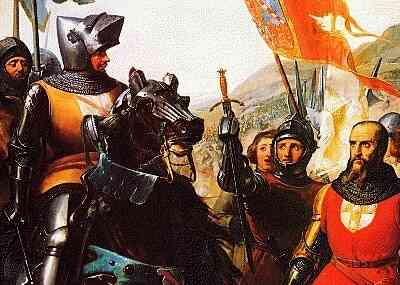 After such a memory, the events of Châteauneuf-de-Randon, which we still have to recount, will seem very small. In 1385, Armand VI, Viscount of Polignac, seeing that he had no direct heir, left by will all his domains to Randon, his brother: namely the baronies of Châteauneuf, Randonat, Solignac, Ceissac, Saint-Paulhan, Saint-Agrève, Servissas, and Molin-Neuf. Randon, Viscount of Polignac and Baron of Châteauneuf, under the name of Armand VII, served with distinction in the armies and was appointed by the dauphin, later Charles VII, as his captain and lieutenant-general in Velay, Gévaudan, Vivrais, and Valentinois (February 4, 1418).
After such a memory, the events of Châteauneuf-de-Randon, which we still have to recount, will seem very small. In 1385, Armand VI, Viscount of Polignac, seeing that he had no direct heir, left by will all his domains to Randon, his brother: namely the baronies of Châteauneuf, Randonat, Solignac, Ceissac, Saint-Paulhan, Saint-Agrève, Servissas, and Molin-Neuf. Randon, Viscount of Polignac and Baron of Châteauneuf, under the name of Armand VII, served with distinction in the armies and was appointed by the dauphin, later Charles VII, as his captain and lieutenant-general in Velay, Gévaudan, Vivrais, and Valentinois (February 4, 1418).
Armand VII died in 1421, having bequeathed his domains to Armand de Montlaur, born of the marriage of his daughter Marguerite with Louis, lord of Montlaur in Vivarais; but an heir of the house of Chalençon, relying on a substitution clause in Armand VI's will, of which he was the grandson, contested the viscountcy of Polignac, the barony of Châteauneuf-de-Randon, and the other lordships dependent on them from Armand de Montlaur. This dispute, which occupied the Parliament of Paris from 1421 to 1464, ended in favor of Guillaume-Armand de Chalençon, great-grandson of Guillaume de Chalençon and Walpurge de Polignac, sister of Armand VI and Armand VII.
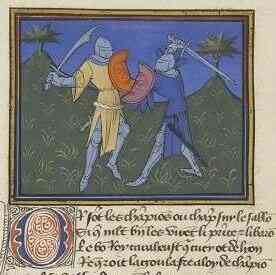 In the person of Guillaume Armand, who took on the name and arms of Polignac, began the branch of Chalençon-Randon. However, amid the debates caused by the succession of Armand VII, an adventurer, André de Ribes, forcibly seized Châteauneuf-de-Randon (1426): he had given the command to a detachment of the band of outlaws of which he had made himself the leader and with the help of which he pillaged the seneschalties of Beaucaire and Toulouse. André de Ribes took the title of bastard of Armagnac, although he had no right, undoubtedly encouraged by the protection of the Count of Armagnac, who favored his criminal endeavors. Louis XI did not forget the conduct of this last lord, and the matter of Châteauneuf-de-Randon featured twenty years later among the accusations he brought against him, for which he granted him letters of pardon (1445).
In the person of Guillaume Armand, who took on the name and arms of Polignac, began the branch of Chalençon-Randon. However, amid the debates caused by the succession of Armand VII, an adventurer, André de Ribes, forcibly seized Châteauneuf-de-Randon (1426): he had given the command to a detachment of the band of outlaws of which he had made himself the leader and with the help of which he pillaged the seneschalties of Beaucaire and Toulouse. André de Ribes took the title of bastard of Armagnac, although he had no right, undoubtedly encouraged by the protection of the Count of Armagnac, who favored his criminal endeavors. Louis XI did not forget the conduct of this last lord, and the matter of Châteauneuf-de-Randon featured twenty years later among the accusations he brought against him, for which he granted him letters of pardon (1445).
Guillaume-Armand II, Viscount of Polignac and Baron of Châteauneuf-de-Randon, participated in the war of the Bien public and went with a body of troops to the aid of the bastard of Bourbon, Bishop of Puy, when he unsuccessfully attempted to seize control of that city. His rebellion was punished with imprisonment and the seizure of the castle of Polignac; but he made peace with the king by marrying his son to the daughter of the Viscount of Dammartin, Grand Master of France, and consenting to the union of one of his daughters with the lord of Lafayette (1465). The ancient barony of Châteauneuf-de-Randon had conferred to the Polignac-Chalençon the right to sit in the States of Languedoc; this privilege was preserved when, at the end of the 15th century, the number of baronial deputations from Gévaudan was reduced.
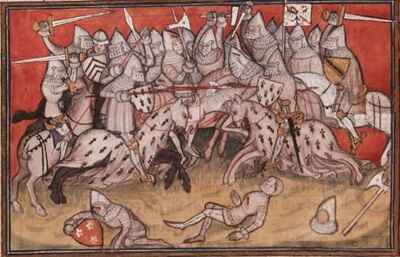 In 1533, François-Armand, Viscount of Polignac and Baron of Randon, went to Brioude, followed by a hundred gentlemen, his vassals, to meet François I. The king, escorted by him, went to the castle of Polignac, where he spent the night of July 17. During the troubles of Religion and the League, the lords of Polignac and Randon sided with the Church and subsequently supported the king’s party. However, Claude-Armand, from François-Armand's first marriage, irritated with his father, who wanted to force him to embrace the ecclesiastical state to leave his domains to his younger brother Louis, from a second marriage, took up arms to avenge himself with the Calvinists and led their troops against his family’s domains.
In 1533, François-Armand, Viscount of Polignac and Baron of Randon, went to Brioude, followed by a hundred gentlemen, his vassals, to meet François I. The king, escorted by him, went to the castle of Polignac, where he spent the night of July 17. During the troubles of Religion and the League, the lords of Polignac and Randon sided with the Church and subsequently supported the king’s party. However, Claude-Armand, from François-Armand's first marriage, irritated with his father, who wanted to force him to embrace the ecclesiastical state to leave his domains to his younger brother Louis, from a second marriage, took up arms to avenge himself with the Calvinists and led their troops against his family’s domains.
Claude-Armand took the town of Genouillac, massacred the monks of the Jacobin convent founded by his ancestors, completely razed this monastery, and penetrated armed into the baronies of Randon and Randonat, seizing them and committing all sorts of violence there. François-Armand hastened to gather his vassals, went in search of his son, encountered him, and defeated him; but overwhelmed with grief, he did not survive long after this sad advantage (1562). After the death of his father, Claude-Armand took possession of all the castles and lands of the houses of Randon and Polignac, to the exclusion of his brother Louis. He died in 1564 without heirs, leaving his inheritance to his father-in-law, Claude-Juste, lord of Tournon; however, this donation was overturned by the Parliament of Toulouse, whose justice Louis had invoked, and which declared in his favor (1671).
The reputation of the lords of Polignac and Randon does not seem to have suffered little from these internal dissensions; one could notice this kind of moral decline at the provincial estates of Gévaudan, held in Mende, in 1605. The Viscount of Polignac, as Baron of Randon, disputed precedence there with the Count of Apchier; the latter, by the decision of his peers, prevailed. Villefort, brother of the Count of Polignac, a man of violent character, could not bear this affront. The next day, followed by some gentlemen, his friends, and his most devoted servants, he attacked d'Apchier mid-service in the cathedral of Mende, leaving him mortally wounded in the square; but three gentlemen from his side and two of his servants were killed in this brawl. Villefort paid for the murder of d'Apchier shortly afterward in Toulouse, where, by sentence of the parliament, he had his head severed in the Saint-Georges square.
With this tragic event, our notes on the barony of Randon end, which, starting from the 12th century, fades into the genealogical history of the house of Polignac. As for the town, we have not been able, despite the most thorough investigations, to determine whether it took part in the civil wars of Gévaudan during the reign of Louis XIII. We have also been unable to find the date of the castle's destruction; it was probably razed, like so many other fortresses, after the pacification of the province. Of this old castle, whose memory will live eternally in our history, nothing remains but ruins.
![]() Châteauneuf-de-Randon, one of the chief towns of the arrondissement of Mende, counts today a little over 600 inhabitants. A simple monument, erected in 1820, in the hamlet of Bitarelle, is all that recalls the death of Bertrand Du Guesclin. Nine fairs, frequented by local merchants and where considerable trade takes place, periodically give this small town a lively appearance. History of the towns of France. Published by Aristide Guilbert
Châteauneuf-de-Randon, one of the chief towns of the arrondissement of Mende, counts today a little over 600 inhabitants. A simple monument, erected in 1820, in the hamlet of Bitarelle, is all that recalls the death of Bertrand Du Guesclin. Nine fairs, frequented by local merchants and where considerable trade takes place, periodically give this small town a lively appearance. History of the towns of France. Published by Aristide Guilbert
Former holiday hotel with a garden along the Allier, L'Etoile Guest House is located in La Bastide-Puylaurent between Lozere, Ardeche, and the Cevennes in the mountains of Southern France. At the crossroads of GR®7, GR®70 Stevenson Path, GR®72, GR®700 Regordane Way, GR®470 Allier River springs and gorges, GRP® Cevenol, Ardechoise Mountains, Margeride. Numerous loop trails for hiking and one-day biking excursions. Ideal for a relaxing and hiking getaway.
Copyright©etoile.fr